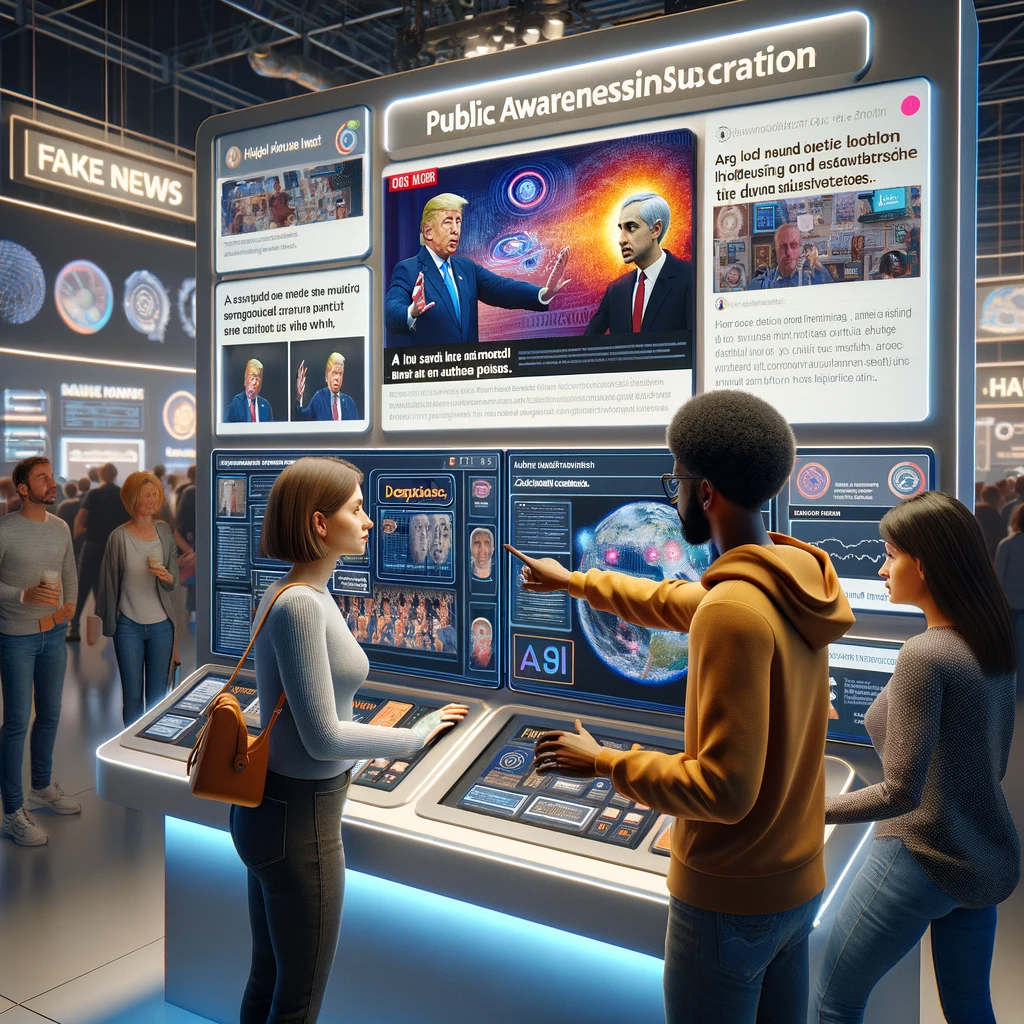In an age where information is as accessible as it is abundant, the proliferation of disinformation and fake news has become a critical challenge. The digital era has facilitated the rapid spread of misinformation, blurring the lines between fact and fiction, and impacting everything from individual beliefs to global politics. This deluge of deceptive content not only misleads the public but also erodes trust in media and institutions, making it a pressing concern in our society.
Enter Artificial Intelligence (AI) – a tool with the potential to revolutionize the battle against fake news. AI’s ability to analyze vast amounts of data, recognize patterns, and learn from them, positions it as a promising ally in identifying and mitigating the spread of misinformation. However, this potential solution is not without its complexities. The central question arises: Can AI effectively address the multifaceted challenges posed by fake news?
This article aims to explore this question in depth. We will examine the current landscape of disinformation and fake news, delve into the ways AI is being employed to detect misinformation, and discuss the challenges and limitations of using AI in this context. Additionally, we will navigate the ethical considerations surrounding AI’s role in content moderation. Through this exploration, we aim to provide a comprehensive understanding of AI’s potential as a tool in the fight against disinformation.

The Rise of Disinformation and Fake News
Disinformation and fake news refer to false or misleading information presented as news, often with the intent to deceive. While misinformation is inaccurate information spread without malicious intent, disinformation is deliberately crafted to mislead or manipulate public opinion. A notorious example is the 2016 U.S. presidential election, where social media platforms were flooded with false narratives influencing voters’ perceptions.
Digital platforms have significantly exacerbated the spread of such content. The advent of social media has created an environment where information, irrespective of its veracity, can circulate rapidly and widely. Algorithms designed to engage users often inadvertently prioritize sensational or divisive content, which includes fake news. The echo chamber effect, where users encounter only information aligning with their existing beliefs, further entrenches these narratives.
The impact on society is profound. Disinformation campaigns have swayed elections, fueled conspiracy theories, and deepened societal divisions. In politics, they can tarnish reputations and skew democratic processes. Public opinion, influenced by a relentless stream of fake news, can be diverted from factual, critical thinking, leading to widespread misconceptions and social unrest.
Current Methods of Detecting Fake News
Traditional methods of detecting fake news revolve primarily around human-led fact-checking. Fact-checkers verify information against credible sources, often involving extensive research and cross-referencing. Organizations like PolitiFact and FactCheck.org exemplify this approach, scrutinizing statements made by public figures and media outlets.
However, these methods face limitations in the digital age. The sheer volume and velocity of information online make it impractical for human fact-checkers to address every piece of potentially false content. Additionally, human bias and error can affect the objectivity and effectiveness of fact-checking.
Artificial Intelligence (AI) has emerged as a complementary tool to enhance these efforts. AI can analyze data at a scale unmanageable for humans, quickly identifying patterns indicative of fake news. With capabilities like natural language processing and machine learning, AI can assist in preliminary filtering of content, flagging suspicious items for further human review. This synergy between AI and traditional fact-checking methods holds the potential to create a more robust defense against the tide of misinformation.

AI Technologies in Detecting Misinformation
Artificial Intelligence (AI) technologies, particularly Natural Language Processing (NLP) and machine learning, are increasingly being utilized to detect fake news and misinformation. NLP allows AI systems to understand and interpret human language, enabling them to analyze news content, social media posts, and other digital texts for signs of falsity.
Machine learning, a subset of AI, involves training algorithms on large datasets to recognize patterns and anomalies indicative of fake news. These algorithms can be trained to identify linguistic cues such as sensationalist language, inconsistencies in storytelling, and patterns that deviate from verified factual reports. Over time, as the AI system is exposed to more data, its accuracy in detecting fake news improves.
One prominent example of AI in action is Facebook’s deployment of machine learning tools to flag potentially false stories, which are then reviewed by human fact-checkers. Similarly, the AI platform ‘GROVER’ developed by the Allen Institute for AI, is capable of both generating and detecting fake news, demonstrating the potential of AI to understand the nuances of fabricated content.
Challenges and Limitations of AI in this Context
Despite the promise of AI in combating misinformation, there are significant challenges and limitations. One major concern is algorithmic bias. AI systems, reliant on data for learning, can perpetuate and amplify biases present in the training data. This can lead to skewed detection of fake news, potentially overlooking or misidentifying content based on these biases.
Differentiating between satire, opinion pieces, and actual fake news is another challenge. Satire, which is often intentionally exaggerated and not meant to be taken literally, can be difficult for AI to distinguish from genuine misinformation. Similarly, opinion pieces, which may present biased but not necessarily false viewpoints, can also be wrongly flagged.
Furthermore, the tactics used in disinformation campaigns are constantly evolving, making it difficult for AI systems to keep up. Adversaries engaged in spreading fake news are continually finding new ways to bypass detection, requiring AI algorithms to be regularly updated and retrained.
In conclusion, while AI technologies provide valuable tools in identifying fake news, their effectiveness is limited by issues like algorithmic bias and the evolving nature of disinformation. Ensuring that AI can effectively combat fake news requires continuous refinement of algorithms and an understanding of the complex landscape of online information.
Ethical Considerations and Risks
Employing AI to combat fake news raises significant ethical questions, particularly concerning the balance between curtailing misinformation and upholding freedom of speech. The use of AI in this context walks a fine line – while it aims to protect the public from deceptive content, there is a risk of inadvertently suppressing legitimate free expression. The challenge lies in ensuring that AI tools do not overreach, mistakenly censoring content that is controversial or unconventional but not necessarily false.
Another critical concern is the potential misuse of AI for censorship. In authoritarian regimes or under unscrupulous corporate policies, AI could be exploited to suppress dissent or unfavorable opinions under the guise of fighting fake news. This misuse could lead to a chilling effect on free speech, where individuals and groups are hesitant to express their views for fear of unwarranted censorship.
Furthermore, the ethical implications of AI monitoring and controlling information are profound. There is a risk of creating an Orwellian scenario where AI, backed by powerful entities, becomes a tool for information control rather than a means of promoting truth. Transparency in how AI algorithms identify and filter content is crucial to prevent such outcomes. Public understanding and oversight of these AI systems are necessary to ensure they serve the public interest without encroaching on individual rights and freedoms.
Future Directions and Potential Solutions
Looking forward, advancements in AI technology promise more sophisticated tools for detecting fake news. Improvements in understanding context, sarcasm, and subtleties in language could enhance AI’s accuracy. Developing AI systems that can learn from a diverse range of data sources will also be crucial in minimizing biases and ensuring comprehensive coverage.
Collaboration between technology companies, governments, and media organizations is essential in this endeavor. Such partnerships can facilitate the sharing of resources, expertise, and data, making AI tools more effective and wide-reaching. Tech companies can provide innovative AI solutions, governments can offer regulatory guidance and support, and media organizations can contribute with expert fact-checking and content analysis.
There’s also a growing call for global standards or regulations specifically for AI in news verification. These standards could provide a framework for ethical AI use, ensuring that efforts to combat fake news do not infringe on human rights. International cooperation in developing these standards could help in addressing the global nature of the disinformation problem, setting a precedent for responsible and ethical use of AI in information management.

